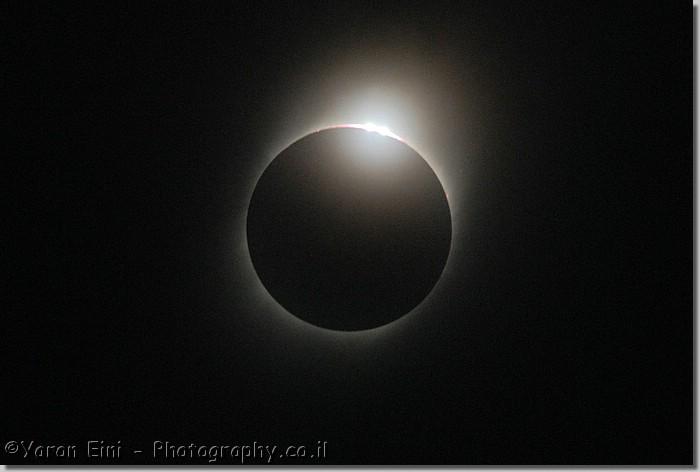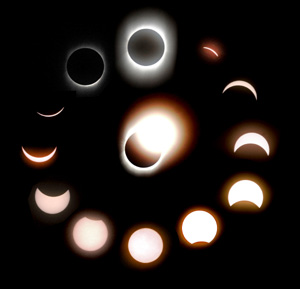Yaron Eini, one of the participants of the Israel Astronomical Society's trip to China, reports to the science website that in light of the harsh weather in Shanghai, the group, numbering 90 people, moved about 200 km from Shanghai.

The Chinese are disappointed by the many clouds that interfered with viewing yesterday morningThe solar eclipse of July 22nd 2009. Those who were lucky, although they at least tried to help him were the participants of the journey of the Israel Astronomical Society to East China. Yaron Eini, one of the participants of the Israel Astronomical Society's trip to China, reports to the science website that in light of the harsh weather in Shanghai, the group, numbering 90 people, moved about 200 km from Shanghai.
"It was a rainy and cloudy day and until about five minutes before the total eclipse we couldn't see anything. About five minutes before the total eclipse it got a little brighter and we saw the eclipse through the clouds so we had a time window of about five minutes before the total eclipse 6 minutes of the total eclipse and another five minutes after. We watched the eclipse in one of the villages from an elementary school full of construction workers who were working during the children's free time for the next school year. During the eclipse, local cars drove by who probably weren't that interested in the eclipse."
The members of the Astronomy Society spent two weeks in China as part of an organized fall, towards the end of which its members experienced the solar eclipse.

One dead and several injured in India during the solar eclipse
Despite all the preparations and outreach, there were still those who began to flee in panic. When the solar eclipse began yesterday in Varanasi, India, thousands began to gather and watch the eclipse. One woman died and several were injured in the escape. Earlier that morning, millions of Indians were baptized in the Ganges River, which is considered sacred to them, a step of purification and cleansing of sins. The people began to sing and pray to the sun. Many in India believe that bathing in the Ganges during a solar eclipse brings good luck.
The believers who had gathered in Varanasi tried to enter the depth of the river, but some of them were crushed by the crowd. One of the eyewitnesses claimed that there was no police presence at the scene, and the crowd was so high that it was absolutely impossible to escape.
NASA marked the small village of Targana in the state of Bihar in India as the center of the eclipse, and thus the village was flooded with tourists, but cloudy skies meant that the residents there would have to wait another century for the total solar eclipse to pass there
And there were more lucky ones, while millions of Indians, Chinese and many tourists in both countries were disappointed by the cloud cover, which was especially thick in the Tibet region and in the city of Shanghai, there were those who soared above the clouds, to a height of about 11 km to get a clear view of the eclipse - they exceeded a number Chartered planes and took off from New Delhi in the path of the eclipse.
Bangladesh also enjoyed the eclipse
The eclipse that everyone was waiting for was also observed in the northwestern districts of Bangladesh, although there it lasted only 3-4 minutes. Panchagara district, the city closest to the middle line of the eclipse path was declared earlier as the eclipse capital of 2009 in Bangladesh. About 30 million people live in the area. The rest of the country's residents had to settle for a partial eclipse.

9 תגובות
Doron:
Write black on a screen for 370 years.
As for your calculation - it says that there is a difference of 120 degrees in the longitudes and a small difference in the latitudes so that after three cycles it just returns to the same longitude but not to the same latitude.
One cycle is 18 years, 11 days, 8 hours.
Then the defects repeat themselves, but on the sphere they occur by moving a third of the circle, 120 degrees.
After 3 such saros cycles, the next eclipse returns to the starting point on our sphere,
Like 54 years and 34 days ago.
Best regards
Doron Rosenblum
Doron Rosenblum:
In Wikipedia - in the chapter dealing with solar eclipse cycles -
http://en.wikipedia.org/wiki/Solar_eclipse#Occurrence_and_cycles
It says, among other things:
Total solar eclipses are rare events. Although they occur somewhere on Earth every 18 months on average,[14] it has been estimated that they recur at any given place only once every 370 years, on average
Hello my father,
Why do you write that the next eclipse is the same one that NASA mentioned,
Will it be in 100 years?
After all, there is a cycle of 54 years and 34 days in which every eclipse of its form and type will appear
on the same place on earth.
Best regards
Doron Rosenblum
I posted a comment and it's not here?
Idan enjoy
Link to a thread on the subject that I happened to open
http://hwzone.co.il/community/index.php?topic=408115.0
From a few months ago
Idan:
Beyond the fact that, as Ariel pointed out, the match is not exact, the degree of match changes over time.
This is what causes, among other things, the abnormality of the current eclipse that lasts longer than usual.
The change over time is not only due to the fact that the orbits of the earth around the sun and the moon around the earth are elliptical, but also from the fact that the moon is constantly moving away from the earth.
In millions of years there will no longer be any alignment and the eclipse will always be clearly annular.
Millions of years ago the eclipses were full in most parts of the Earth and lasted longer.
Age, it is not, in most places the moon casts a partial shadow on the earth and only in a very small part there is a full shadow. In some cases there is no total solar eclipse at all anywhere on Earth but only an annular eclipse.
What amazes me the most about the solar eclipse is this
That the moon is just the right size and the exact distance to hide the sun neither too little nor too much